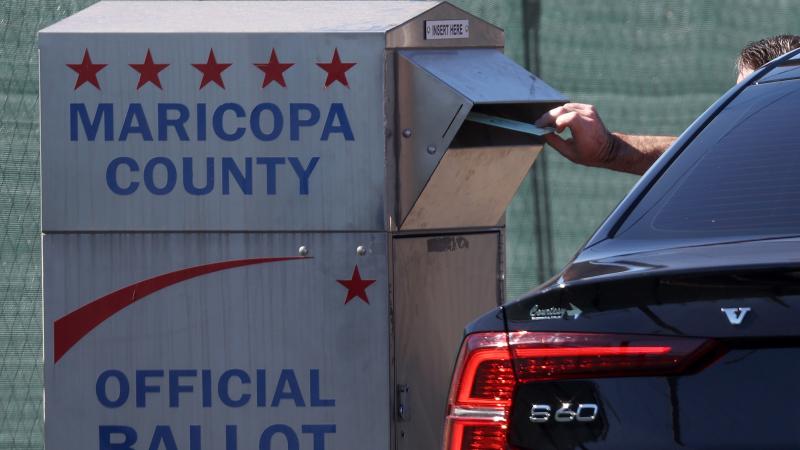Third-party voters from 2016 are breaking for Biden, imperil Trump margins in battlegrounds
"It's a warning sign" for the Trump campaign, said pollster Scott Rasmussen. "Maybe it's a yellow flag as opposed to a red flag. And it is one of many things that could change in the three states that shocked everybody: Pennsylvania Michigan and Wisconsin."
Third-party voters were a major factor helping President Trump's 2016 victory, but early polling data suggest these voters could possibly hurt him in 2020 if they turn out in the same numbers and vote instead for Democratic opponent Joe Biden.
However, the Trump campaign said it believes it will tap into enough new voters — polls suggest Trump is gaining ground with minority voters, especially Latinos and African-Americans — to overcome any third-party swing votes to Biden.
During the 2016 election, the number of third-party voters far exceeded President Trump's margin of victory in places like Michigan, Pennsylvania and Wisconsin. NBC News/Wall Street Journal polls from 2020 found that third-party voters from 2016 say they back Biden by a 2-to-1 margin. The polling found 47% percent said they plan to vote for Biden, 20% plan to vote for Trump, and 33% are unsure or say they’re backing "another candidate.”
"Here's why this is significant: In 2016, Trump won Michigan by 10,704 votes, while the combined Johnson/Stein vote was 223,599. (So Biden getting 47 percent of that third-party vote to Trump's 20 percent easily overturns that '16 margin.)," NBC News reported on Monday. "In 2016, Trump won Pennsylvania by 44,292 votes, while there were 196,656 Johnson/Stein voters. (Again, Biden winning those third-party voters by a 2-to-1 margin reverses that outcome.) And in 2016, Trump won Wisconsin by 22,748 votes, and the combined Johnson/Stein total was 137,746. (Ditto: Hillary Clinton would likely be president today if she had won those third-party voters by a 47 percent to 20 percent split.)"
For the Trump campaign "it's a warning sign," said veteran pollster Scott Rasmussen, author of the Just the News Daily Poll. "Maybe it's a yellow flag as opposed to a red flag. And it is one of many things that could change in the three states that shocked everybody: Pennsylvania Michigan and Wisconsin."
However, Rasmussen said that any polling on third-party voters should be read with caution, given their small size relative to the general population, making sampling more difficult.
"I don't want to dismiss the poll," Rasmussen said. "It is quite possible that people who said they voted third party last time, are more likely to back Biden this time. But I am always skeptical of any polls claiming any precision on a topic like that."
Rasmussen also said that often people forget how they voted, saying that "one of the earliest and most dramatic examples of this in polling history was after John Kennedy was assassinated something like 80% of Americans said they voted for him in 1960."
Polls in the months after the terrorist attacks of 9/11 also found the number of people who said they voted for George W. Bush was higher than it actually was, said Rasmussen, but by 2008 and the financial meltdown it was lower than it was.
"So there's always going to be a little bit of your memory is not perfect," Rasmussen continued. "And if you voted for Trump last time after thinking you were going to vote third party and you've soured on him, you might kind of convince yourself you really did vote third party last time."
Rasmussen said perhaps a better litmus test would be to ask people who are uncommitted which way are they leaning.
"They do lean a little more to Biden than to Trump," Rasmussen said of his own polling research.
Less than 10% of voters in the Just the News Daily Poll released Monday planned to vote for third-party candidates or were unsure of whom their eventual choice would be. That poll also shows Biden clinging to a narrow 4-point lead over President Trump nationally, amid mounting evidence of a tightening race.

The L.A. Times also reported on a 2020 shift tracked by the University of Southern California Dornsife Daybreak Poll. "Another big difference from four years ago: Third-party candidates get only 2% support now, much less than in 2016, when smaller parties took 5% of the vote."
The Biden campaign did not respond to request for comment from Just the News.
The Trump campaign said in a statement that it was focused on growing Trump's coalition of support. Indeed, the 2020 Republican National Convention's diverse speaker lineup channeled the 1980s-vintage "big tent" Republican Party that helped Ronald Reagan thrash Walter Mondale in a 49-state win and carry George H.W. Bush to victory in 1988.
“President Trump realigned the political map in 2016 and he continues to tap into an organic enthusiasm from those who were disillusioned with career politicians like Joe Biden," Samantha Zager, Deputy National Press Secretary, told Just the News. "With his record of success, President Trump is exciting new voters and expanding on his already broad coalition of support that will carry him to victory in November.”
The Facts Inside Our Reporter's Notebook
Links
- Trump is gaining ground with minority voters
- Latinos and African-Americans
- NBC News reported on Monday
- Less than 10% of voters in the Just the News Daily Poll released Monday planned to vote for third-party candidates
- The L.A. Times also reported on a 2020 shift tracked by the University of Southern California Dornsife Daybreak Poll
- 2020 Republican National Convention's diverse speaker lineup channeled the 1980s-vintage "big tent" Republican Party
Other Media
















